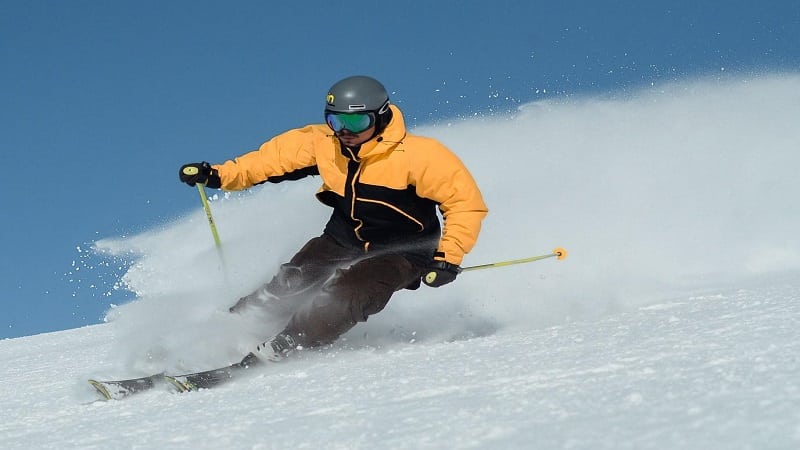The optimal snow depth can vary for different places. In short, it depends on what lies beneath the snow.
What is Good Snow Depth for Skiing?
In certain Austrian locations, pistes are constructed on grassy plains. Hence, as little as 5 to 10 centimeters of snow is sufficient for such pistes.
However, not all skiing destinations are that smooth. For instance, in the Canadian Rockies, where the terrain is far more uneven and jagged, you will need far more snow to ski smoothly and safely.
The question of snow depth is also influenced by the sort of base you are looking at. Is this the first snow layer of the winter season or a packed hard layer of preexisting snow?
If it is the first winter snowfall, then it is necessary to compact this snow fast so that the wind does not blow it away from the mountain. Also, compacted snow does not melt as quickly under the sun.
Hence, those tracks that are not pisted frequently require a greater depth of snow for good skiing conditions. A pisted slope, on the other hand, will work well with a shallower depth of snow.
High snowfall later on in the winter season is a sign for you to pack your gear to start skiing. Fresh snow falling on preexisting snow will make for some really nice skiing conditions. Hence, if there is a 20 to 30-centimeter snowfall on top of preexisting snow, then this is a good time to hit the slopes.
Winter buffs look forward to falling mercury and the onset of winter for one key reason – snow. There is snow for only a few months of the year. Hence, avid winter sports fans can make the most of the winter season by heading out to the slopes when there is sufficient snowfall.
With abundant snowfall and fresh snow piling up in front of your door, you can think of having fun in the snow.
For kids, at least, snowfall can be a source of joy since they can have the day off and caper in the snow. While kids get hold of their sleds and head out to the hills, grownups prefer to visit their favorite ski resorts for a fun-filled winter vacation.
Even when there is a little snowfall, kids can gleefully climb grassy hills and race downhill in their sleds. But how much snow do you need to ski on a big mountain safely?
Ski bums, resort managers, and winter sports fanatics will agree that optimal snow depth is dependent on a couple of factors. A great skiing experience depends on these factors.
Out of all these factors, snowfall is certainly the most vital.
Terrain Types
But how much snow will suffice? The answer to this question depends on what lies below the snow.
In certain areas, pistes run through grass plains. Pistes are trails or slopes built for skiing fun. Since the terrain here is pretty smooth and even, you don’t need much snow around these parts. Around 2 to 4 inches of snow is enough for such places.
However, other pistes go through rocky and uneven terrain. For such mountainous parts, a few feet of snow is necessary for covering up the rocky track and rendering it smooth for ardent skiers.
Winter resorts don’t necessarily need the highest snowfall to count among the very best for skiing. Rather, it is more important for these resorts to have a more sustained snowfall for a longer snow season and, therefore best skiing conditions. That is resorts where snow lasts the longest are ideal for skiing. As you might have guessed, there is little point in running a ski resort if the snow melts quickly in a particular location.
Snow retention depends on a few factors. If there is already a base layer of deep snow, fresh snowfall will last longer.
Artificial Snow
But what if it is the first snowfall of the winter? In such a case, winter resorts rely on heavy equipment to create dense, compacted surfaces that are well-suited for skiing. These tracts are called pistes. When snow is compacted by means of heavy machinery, then it will not be blown away that easily from the slope. It will also not melt that quickly.
HA key factor for ideal skiing conditions is how long a ski resort retains snow. This ability depends on the resort’s altitude, mountain orientation, and weather conditions. The snow will melt more quickly in places with less snowfall and more sun.
Since ski resorts are commercial establishments, they can rely on the weather alone for a dependable supply of snow. They deploy technology for making snow so that their slopes remain covered under a thick white layer for the duration of the winter season.
Hence, it is not unusual to find ski resorts that leverage this technology to make snow-covered ski slopes even before natural fresh snow has fallen. The advantage of this synthetic snow-making technology is that such resorts can open more quickly.
However, ski resorts can’t just make as much synthetic snow as they like. They must avoid a big buildup of artificial snow since heavy snowfall could occur, in which case there will be excessive snow. If that happens, then all sorts of problems might ensue.
If there is an enormous amount of snow, then compacting it becomes a challenge, if not impossible. There is also the risk of avalanches with too much snow, due to which skiing may have to be canceled for safety.
Our Final Thoughts
As explained, a good snow depth for skiing depends on several factors delineated above. Smoother slopes need less snowfall, while rocky tracts need more snowfall for better skiing conditions.

















